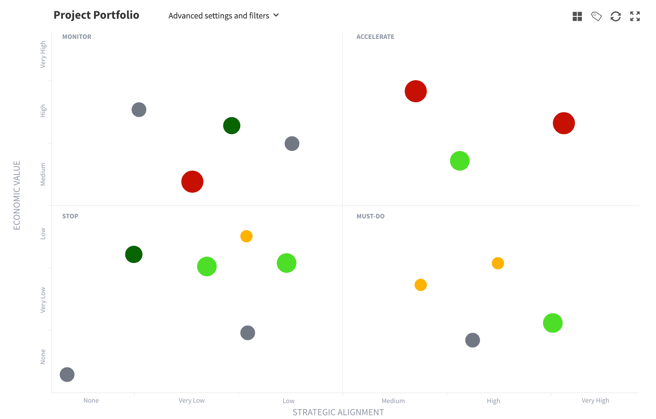If a company wants to create new products from unproven technologies, risk is unavoidable. In innovation management, you have to anticipate possible futures and emerging societal needs. To deliver on what customers will expect five years from now, you have to ideate and plan for that now.
In order to de-risk your company’s innovation investments, three principles are important: prioritizing, transparency, and understanding internal capabilities.
1. Prioritize with technology portfolios
The first step to de-risk investments in innovation is collecting evidence for expected changes in your company’s business environment. Environmental scanning software reliably identifies trends, technologies, and developments in any market. You can then use that as evidence for decision-making. To take bold bets on the future and navigate through risks, you need to make sense of the abundance of available data. By automating scouting, scanning, and monitoring activities, teams gain more time for what matters most: decision making. Software makes it possible to do Continuous Foresight, which involves relentlessly monitoring change in an ever-evolving landscape and determining how to respond.
→ Explore how to scan, scout, and monitor your Business Environment with ITONICS Insights
Scenario planning is a strategic planning method to anticipate possible futures. By understanding future scenarios, organizations can mitigate risks that are likely to arise. Scenario planning produces narratives about the future that companies can use to identify opportunity spaces in which to play and ultimately direct their innovation strategy. Preparing for multiple scenarios strengthens robustness and decreases risk.
A matrix grid is another method to decide what to prioritize for investment. Plot the potential of an innovation idea against its risk or the challenge of implementation. The matrix can help teams think about the possible technologies to invest in and decide which ideas to put on hold, which to abandon, and which to prioritize.
While prioritizing is key, that does not mean you should focus on one innovation at a time. A good way to minimize the overall risk of your innovation efforts is not to put all your eggs in one basket. If the company's future rests on the success of one innovative product, you could lose everything if that one product fails. Diversify your innovation efforts. Start with small initiatives and test and validate them before scaling up. One practical approach is to create a dedicated innovation lab, where the team can run quick pilots with a ‘fail fast’ attitude.
Managing your portfolio is an ongoing process. Emerging technologies might open new opportunities, while unforeseen societal shifts may pose a significant risk. Cooperating with a new business partner could provide a competitive advantage. There may even be a startup that aligns with your company’s innovation goals and thereby presents an investment opportunity. You need an early-warning system in place to spot and monitor emerging risk areas in your corporate landscape. Continuous foresight is necessary to recognize changes in your business environment at an early stage, prioritize the appropriate response and prepare for the future.
2. Create transparency with technology roadmaps
Innovation management is interconnected throughout the entire organization. As a result, it can be complex and difficult to oversee. That is why it’s essential to have a single source of truth for all teams to see. If a company lacks transparency, resource planning and allocation may end up disjointed. Decision-making will be strenuous. To achieve consensus, you need to make it easier to inform stakeholders and allow input and overall visibility. Easy exporting of reports is an essential feature in innovation management software.
Roadmapping is also critical in consensus-building and crafting future business capabilities. It indicates where contingency plans need to be made. An innovation roadmap enables a team to plot out the scenario events and work backward to develop a timeline of innovation efforts needed to take advantage of opportunities in good time. Companies use roadmaps to connect internal capabilities with external drivers and flesh out a timeline to get consensus on their innovation goals. Roadmapping is an exercise in strategic planning. It lays out the journey, consolidates resources, and develops reasonable milestones. This makes it possible to identify shortcomings in the plan and thereby minimize risk. Transparency is therefore essential to de-risk innovation investment.
3. Understand internal capabilities
Imagine your business has a game-changing idea for a new service. However, the technology involved is very specialized—none of the teams know how to implement it. The concept will fail if your company does not have the internal capabilities to capitalize on it. That is why roadmapping also involves thinking about human resource requirements. To avoid the risk of pumping resources into developing a service that teams are unable to deliver, it is key to think through the people you will need to execute the vision. Build capability first in order to innovate successfully. Carve out those opportunities that the company is best placed to capitalize upon. You can also scout for a startup that already has the required skills and then acquire it. This can speed up your innovation efforts by assimilating the startup’s much-needed capabilities.
|
De-risking innovation with the ITONICS Innovation OS |
|||
|
Prioritize with |
|
|
|
|
Gain transparency with |
|
|
|
|
Understand internal capability with |
|
|
|
Using the ITONICS Innovation OS to focus the right innovation opportunities
The ITONICS Innovation OS allows you to apply all these methods to focus on the right innovation opportunities and to de-risk innovation investments. We lead companies through three strategic innovation questions:
1. Where to Play: understand changes in your company's environment using the ITONICS Radar and Insights tools. Analyze data from a variety of sources to anticipate emerging needs. Environmental Scanning enables you to identify potential drivers of change and gather evidence for expected future scenarios. The World View and Timeline visualizations in ITONICS Insights allow you to compare developments across geographies and see how trends, technologies, startups, or competitors evolve over time. By understanding consumers' changing attitudes, you can plan to meet future demands. Discover new technologies that meet these needs and gather evidence to de-risk those investments.

2. How to Win: boost the creative process with ITONICS Campaigns by involving internal and external participants in developing new ideas. Our collaborative innovation platform provides flexibility with best practice blueprints included. Engaging your entire organization can foster a culture of innovation and empower better decision-making. Harness the power of the crowd, both internally and externally, to generate a diversified set of possible solutions. ITONICS Portfolio makes it possible to align company-wide innovation activities and ensure transparency. This decreases the risk of inefficient misalignment and wasted effort. Use the ITONICS Portfolio to balance your innovation ambitions with internal capabilities and realize their potential. With the ITONICS Innovation OS, you can develop and oversee a balanced investment portfolio.

3. What to Execute: track implementation activities and progress over time with the ITONICS Roadmap. This is the tool for all your efforts in agile planning and execution. Identify the key technologies and resources needed for product development to avoid being unequipped for the future. Innovation teams should look at the trajectories of key drivers of change and imagine multiple outcomes. Explore the scenarios that hold the most strategic relevance to your company and consider events that may play out in the future. Teams can plot these eventualities on the ITONICS Roadmap tool to think about how to address the risks and opportunities.
%20Portfolio%20Webinar%20-%20Strategy%20Roadmap.webp?width=946&height=533&name=13)%20Portfolio%20Webinar%20-%20Strategy%20Roadmap.webp)
Risk is a reality in the business of innovation. A company should not strive to eliminate the risk altogether but rather reduce it. Without risk, there can be no big reward. Organizations naturally want to avoid the risk of an embarrassing product failure, but individual risks must be managed by fitting them into a diverse portfolio to reduce overall risks. Innovation management software is there to help you identify risks and minimize them to manageable levels. Build a culture of innovation at your company where transparency is valued, teams understand their own capabilities to deliver, and can prioritize ideas with the most potential and strategic fit. To decrease the risk of innovation investment, the ideal is to establish repeatable and scalable processes with a centralized repository for knowledge sharing. That way, even if an initiative fails, the stakes are lowered, and teams can learn from what has worked and what has not.
FAQs on de-risking innovation investments
How do digital platforms enable effective innovation governance?
Digital platforms like ITONICS support innovation governance by centralizing opportunity portfolios, embedding evaluation criteria, visualizing risk exposure, and enforcing consistent decision-making workflows across the innovation lifecycle.
How can companies reduce risk in innovation investments?
By linking opportunity scouting to portfolio management, digital platforms help organizations assess strategic fit, technical feasibility, and market potential early—minimizing costly missteps.
What role do foresight tools play in prioritizing innovation?
Foresight tools integrated in innovation platforms surface emerging trends and risks, enabling leaders to adjust priorities proactively and align investments with future market realities.




